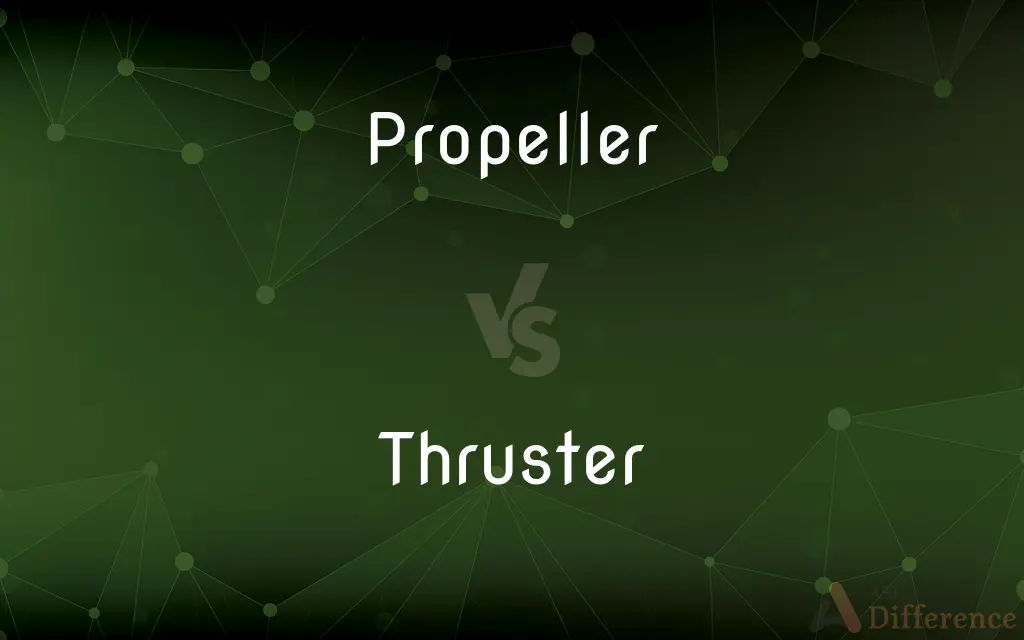Propeller vs. Thruster — What's the Difference?
By Fiza Rafique & Urooj Arif — Updated on March 25, 2024
Propellers are devices that move an object by pushing against a fluid, while thrusters provide directional control and propulsion in water or space.

Difference Between Propeller and Thruster
Table of Contents
ADVERTISEMENT
Key Differences
Propellers work by rotating blades to push air or water, creating lift and forward movement. They are commonly used in airplanes and boats, where their design and efficiency in converting rotational power into thrust are crucial. Propellers operate by exploiting Bernoulli's principle, where the difference in pressure on either side of the blades propels the vehicle forward. On the other hand, thrusters, such as bow thrusters or space thrusters, are specialized for maneuvering rather than sustained speed. They provide additional directional control, allowing for precise movements in challenging conditions, such as docking ships or adjusting the orientation of spacecraft.
Propellers are generally larger and designed for continuous operation over long distances. Their efficiency is key in applications like commercial aviation or maritime transport, where fuel economy and speed are paramount. Thrusters, in contrast, are often smaller and used for short bursts of power. They are crucial for precise positioning rather than long-distance travel, making them indispensable in applications like station keeping in space or tight maneuvering in harbors.
In terms of energy source, propellers are typically powered by engines that convert fuel into mechanical energy, which is then transferred to the propeller blades. This setup is common in both aviation and marine contexts, where the focus is on efficient, continuous propulsion. Thrusters, however, may utilize a variety of energy sources, including electric motors and gas jets, especially in spacecraft, where compact, efficient systems are necessary for attitude control and orbital maneuvers.
The design considerations between propellers and thrusters also differ significantly. Propellers must be carefully designed to minimize drag and maximize thrust, with factors such as blade shape, pitch, and material being critically important. Thrusters, on the other hand, are optimized for their ability to deliver force in specific directions, with less emphasis on efficiency over long periods and more on immediate response and control.
While both propellers and thrusters serve to move and control vehicles, their applications highlight their differences. Propellers are the backbone of efficient, long-distance travel in air and water, pushing against the medium to generate thrust. Thrusters provide the finesse in control, offering the ability to maneuver with precision in environments where directionality and positioning are key.
ADVERTISEMENT
Comparison Chart
Purpose
Generates forward thrust for movement
Provides directional control and precise maneuvering
Typical Use
Airplanes, boats
Spacecraft, ships (for docking)
Operation Mode
Continuous for long distances
Short bursts for specific maneuvers
Energy Source
Mechanical energy from engines
Various, including electric and gas jets
Design Focus
Efficiency in fluid, blade shape and pitch
Immediate response, directional force
Compare with Definitions
Propeller
Converts rotational power into thrust.
The motor's energy was transmitted to the propeller, pushing the vessel forward.
Thruster
Used for directional control.
The submarine used its thruster for delicate movements on the ocean floor.
Propeller
A device for propelling a vehicle.
The boat's propeller churned through the water, speeding us along.
Thruster
Often powered electrically or by gas jets.
The satellite's electric thruster maintained its position above Earth.
Propeller
Consists of rotating blades.
The airplane's propeller spun rapidly, preparing for takeoff.
Thruster
A device for precise maneuvering.
The spacecraft's thruster fired, adjusting its orbit.
Propeller
Operates in air or water.
The drone's propeller cut through the air, lifting it effortlessly.
Thruster
Focus on immediate response.
The ship's bow thruster made docking in the tight harbor possible.
Propeller
Designed for efficiency.
The ship's propeller was engineered for maximum thrust with minimal drag.
Thruster
Can operate in space or water.
The underwater robot's thruster allowed it to navigate tight spaces.
Propeller
A propeller is a device with a rotating hub and radiating blades that are set at a pitch to form a helical spiral, that, when rotated, exerts linear thrust upon a working fluid, such as water or air. Propellers are used to pump fluid through a pipe or duct, or to create thrust to propel a boat through water or an aircraft through air.
Thruster
A person or thing that thrusts.
Propeller
A mechanical device for propelling a boat or aircraft, consisting of a revolving shaft with two or more broad, angled blades attached to it.
Thruster
A device that imparts thrust, such as a small rocket engine used to adjust the course or attitude of a spacecraft in flight.
Propeller
A device for propelling an aircraft or boat, consisting of a spinning shaft with radiating angled blades that thrust air or water in the direction opposite the desired direction of travel.
Thruster
One who thrusts, who pushes or stabs.
Propeller
One who, or that which, propels.
Thruster
A device for propelling an object, especially a spacecraft or a ship (marine vessel).
Propeller
A mechanical device with evenly-shaped blades that turn on a shaft to push against air or water, especially one used to propel an aircraft or boat.
Thruster
(nautical) A bow thruster or a stern thruster.
Propeller
A steamboat thus propelled; a screw steamer.
Thruster
(surfing) A surfboard (usually a shortboard) with three fins of approximately equal size, one centred at the back, one on each side about 25cm forward and out near the rails.
Propeller
(fishing) A spinnerbait.
Thruster
An ambitious, driven person; a go-getter.
Propeller
One who, or that which, propels.
Thruster
One who thrusts or stabs.
Propeller
A contrivance for propelling a steam vessel, usually consisting of a screw placed in the stern under water, and made to revolve by an engine; a propeller wheel.
Thruster
One who intrudes or pushes himself forward
Propeller
A steamboat thus propelled; a screw steamer.
Thruster
A small rocket engine that provides the thrust needed to maneuver a spacecraft
Propeller
A mechanical device that rotates to push against air or water
Common Curiosities
Where are thrusters commonly used?
Thrusters are commonly used in spacecraft for orbital maneuvers and in ships for docking and precise positioning.
What are the key differences between propellers and thrusters?
Propellers are designed for efficient, long-distance travel, generating forward thrust, while thrusters are designed for precision maneuvering and directional control.
What is a propeller?
A propeller is a device with rotating blades used to push against a fluid, creating lift and forward movement in vehicles like airplanes and boats.
What is a thruster?
A thruster is a device designed for providing directional control and precise maneuvering in vehicles, often used in spacecraft and ships.
How do propellers work?
Propellers work by exploiting the difference in pressure on either side of their rotating blades, propelling the vehicle forward.
Can thrusters operate in air?
Yes, some thrusters can operate in air, especially in aviation applications for control surfaces, but they are more commonly associated with space and underwater use.
Are propellers less efficient than thrusters?
Propellers are designed for efficiency in continuous operation and long-distance travel, whereas thrusters are optimized for precision and maneuvering, making direct efficiency comparisons context-dependent.
Are electric thrusters becoming more common?
Yes, electric thrusters are becoming more popular, especially in spacecraft and underwater vehicles, for their efficiency and control capabilities.
How does the design of a propeller affect its efficiency?
The shape, pitch, and material of propeller blades significantly affect their efficiency by influencing drag and thrust generation.
What materials are used to make propellers?
Propellers can be made from various materials, including metal alloys, composites, or plastics, depending on their application and required performance.
Do all vehicles with propellers also have thrusters?
Not all, but many large ships and spacecraft combine propellers for main propulsion with thrusters for maneuvering and control.
Can thrusters be used as the main source of propulsion?
While thrusters can provide propulsion, they are typically used for control and maneuvering rather than as the primary source of propulsion for long distances.
How do bow thrusters differ from other thrusters?
Bow thrusters are specifically designed for maneuvering the front of ships, aiding in docking and navigating tight spaces.
Why are thrusters important for spacecraft?
Thrusters allow spacecraft to make precise adjustments to their orbit and orientation, critical for missions and satellite operations.
How do propellers and thrusters contribute to vehicle dynamics?
Propellers provide the primary thrust for movement, while thrusters offer additional control and precision in maneuvering, complementing each other in vehicle dynamics.
Share Your Discovery

Previous Comparison
Serenity vs. Serendipity
Next Comparison
Agent vs. CommissionaireAuthor Spotlight
Written by
Fiza RafiqueFiza Rafique is a skilled content writer at AskDifference.com, where she meticulously refines and enhances written pieces. Drawing from her vast editorial expertise, Fiza ensures clarity, accuracy, and precision in every article. Passionate about language, she continually seeks to elevate the quality of content for readers worldwide.
Co-written by
Urooj ArifUrooj is a skilled content writer at Ask Difference, known for her exceptional ability to simplify complex topics into engaging and informative content. With a passion for research and a flair for clear, concise writing, she consistently delivers articles that resonate with our diverse audience.















































